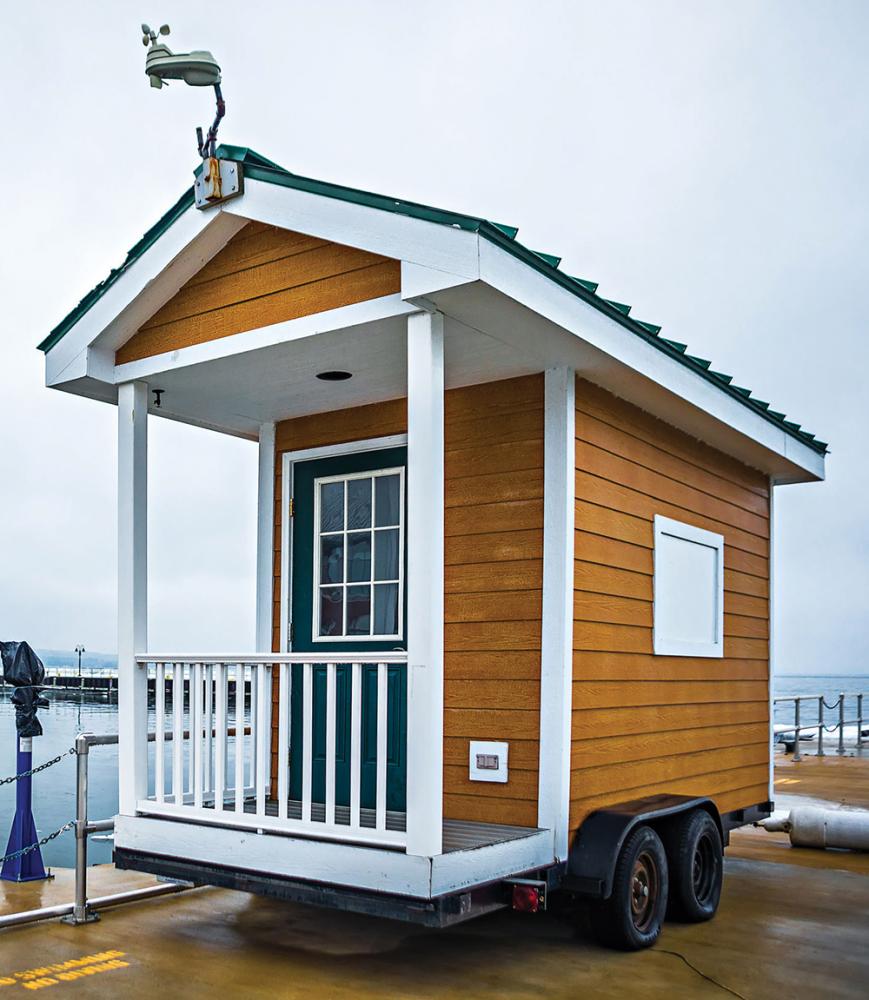
A tiny home on wheels built and owned by Brandon Batchelde and Chloe Barcelou. Courtesy photo
Last year, Joe Mendola, a long-time realtor and senior vice president at NAI Norwood Group in Bedford, was stewing about NH’s lack of affordable housing. Mendola, a resident of Warner, is concerned that the shortage is forcing talented young people to leave the state, dampening the enthusiasm of other potential younger residents and creating a shortage of good employees for growing businesses. “We have 2.7 percent unemployment and 1,800 advanced manufacturing jobs going begging in Hillsboro and Merrimack counties,” he says. “We have [students] graduating from UNH and leaving the state… And we’ve got to stop that.”
Then one night, Mendola followed his wife’s advice and watched a television program about tiny houses. Every segment was filled with college-educated, entrepreneurial young people. Most were couples with either significant college loan debt or strongly motivated to save money for a standard home in the future to raise a family. And nearly all, he says, had a love for the outdoors and a respect for personal freedom that would comfortably fit into the Granite State. “They were that 22-to-35-year-old generation that we wanted,” Mendola says.
So he went to his town with a proposal to develop a tiny home park. The planning board chairman, Ben Frost, who is also director of legal and public affairs for NH Housing Finance Authority, explained, “There’s no zoning for tiny houses.” Mendola would need an exception. The Zoning Board then rejected Mendola’s plan.
Policy Debate
Mendola was disappointed but still intrigued with the idea that tiny houses could supplement the state’s housing stock. He began researching and was surprised to discover that no state in the country had a law permitting year-round parking for “tiny houses on wheels” (THOWs).
Mendola reached out to Frost, informally as a neighbor, and they began working with NH Rep. Dave Testerman of Franklin to draft a bill to make parking THOWs a permitted use in NH. The idea would roughly use the same zoning regulations that the federal Housing and Urban Development requires for manufactured houses, but without the agency’s involvement.
Given that state laws govern so-called mobile-home parks, Frost says a municipality must either allow manufactured housing on private land, in designated parks or in a subdivision specifically for manufactured homes.
When the bill reached the NH House Committee on Municipal and County Government, however, legislators had some vexing questions. How would owners of tiny homes be taxed by local municipalities to help fund local services like police? Would a tiny house be allowed to use the utilities and resources of a standard home if it were sited on the same lot? Would the owner of a tiny house be required to own the land? What would happen if a tiny house was abandoned on someone else’s property?
The drafters of the legislation reluctantly decided to alter their proposal, asking simply for a bill to form a committee to study how tiny houses could work for NH. This past summer, Gov. John Sununu signed the legislation, and Mendola says that after the committee issues a report in the fall, a draft bill will be prepared for the next legislative session.
Big Challenges
But the committee could find that task too complex. There are basically two kinds of tiny houses. Many are just smaller-than-average homes, typically less than 1,000-square feet, built on a standard foundation. The only local zoning issues these cottages or “granny flats” are likely to run into are usually related to minimum lot size, minimum living space or the amount of street frontage required. In light of the current housing crunch, some NH communities are becoming more lenient in these areas, allowing exemptions that would have been impossible years ago.
The policy debate is even trickier for the kinds of tiny houses that Mendola wants to permit. Isa Bauer, who co-owns Tiny House Northeast, says THOWs are typically stick-built structures that sit on a trailer frame, which means they are mobile, as homeowners have the hope of being able to move.

A tiny home built by Tiny House Northeast in Wakefield. Courtesy photo.
But that brings complexity. In NH, many THOW owners live off the grid in rural communities where they are unlikely to be troubled by either local zoning regulations or nosey neighbors. (Tiny home websites highlight Grafton County, where there are several towns with federal and state zoning rules but no local zoning ordinances. Many tiny homeowners won’t tell you exactly where their home is located in order to avoid red tape.)
For those reasons, it is difficult to pinpoint the actual size of this housing segment. “From looking at the number of tiny houses that are sold yearly, we estimate that there are around 10,000 tiny houses in Northern America,” according to the website godownsize.com. “Seven hundred new houses are built every year from certified builders and we estimate that just as many are built privately (i.e., DIYers) ... but, knowing the exact number is an impossible thing.” The website estimates in 2017 alone, sales of tiny houses by certified builders increased 67%.
Tiny-home living requires a significant level of personal commitment, Bauer says, as the owners live in ways that are, at least, eco-friendly and, at best, aimed at full sustainability. “Water is the most difficult,” Bauer says for both drinking water and septic water. Owners create complex systems to ensure safe drinking water and good wastewater disposal, from plant-based cleaning products to composting toilets. Electrical power is simpler but can still include several sources, including rooftop solar arrays and battery backups.
Nationwide, THOW owners have developed a variety of ways to meet these challenges. In some areas, tiny homes can be classified as recreational vehicles (RV), which allows them to park at RV parks and campgrounds where they can plug into services. However, NH does not permit RVs as year-round residences, so owners either have to move to another spot or hope no one notices them holed up in February.
Despite such challenges, tiny homes are growing. Brandon Batchelder, a NH carpenter and writer, built a THOW with his girlfriend Chloe Barcelou and describes the experience on the website of their production art and design company, B&C productions (productionartanddesign.com/thetinyhousestory). “Building our tiny house was far from easy, but the freedom of creativity, the authority to include any idea, no matter how whimsical, and the knowledge that we would one day find ourselves sheltered by our own creation was an experience we can only compare to the building of tree forts in childhood,” he states online. “It felt natural, freeing, even primitive.” (The couple built the structure on the Seacoast but did not want to disclose where it’s parked.)

Brandon Batchelde and Chloe Barcelou inside their tiny home. Photo by Chris Saunders.
While there are companies, like Bauer’s, that build tiny homes to stick-built structure codes, some do-it-yourselfers do not build to code and stumble on unexpected problems with water condensation or finding and sourcing essential utility services. These are the issues the legislative committee must address.
Bridging the Policy Problem
Last year, the International Code Council (ICC) adopted a new appendix to its international residential code that outlines criteria for the acceptance of tiny houses. This could help set parameters for legislation.
“Appendix Q” focuses on the most common problems owners of tiny homes face when dealing with building inspectors: defining a tiny house (THOW) as 400 square feet or less while recommending relaxed limitations related to ceiling space, emergency exits, interior stairs/ladders and lofts. Advocates hailed it as a “good first step.”
But the ICC rules won’t take effect until they’re approved by local governments. In May, Washington became the first state to accept Appendix Q. “They beat us,” Mendola bemoans. Since then, several other states, including Massachusetts and Maine, have voted to adopt Appendix Q into their state statues on Jan. 1, 2020.
Even if the study committee recommends that NH join the Appendix Q parade, there are still issues that need to be addressed, Bauer says. She favors creating a separate building code for THOWs that deals with bolting systems, energy efficiency and structural issues.
However, if NH gets there, Anne Mellin and Sue Schoenfeld of Henniker want to see standardized codes. The self-described “home improvement junkies” started the Tiny Living Spaces company in 2016 because they enjoyed the design challenges. They were one of only four tiny house builders invited to a prestigious home show in Newport, R.I. However, Mellin says they can’t sell their units here because there’s no place to put them, as too many towns are unwilling to explore the idea.
“You wind up going to the town hall, trying to explain it,” Schoenfeld says. “People don’t want them in their backyards.”
Big Ideas Around Tiny Houses

• The tiny house movement was popularized in the 1990s, inspired by back-to-nature trends and spurred on by increased costs and size of American housing, says Isa Bauer of Tiny House Northeast in Wakefield, who has a M.A. in regional economic and social development, with a focus in sustainable development, from UMass Lowell.
• Tiny houses are different than manufactured homes: they are stick-built with an exterior similar to standard homes and they can last for years, Bauer says.
• Costs range from $10,000 for do-it-yourself models to more than $100,000 for a “luxury” tiny house on a foundation, says Bauer. (Tiny house plans are available online.)
• Millennials are especially drawn to tiny homes for lifestyle, savings, mobility and ecological concerns. But interest among other groups is growing, particularly single women and senior citizens, Bauer says.
• Tiny house developments and parks are springing up nationwide. Some cater to specific demographics, like seniors.
• Tinyhouselistings.com had 10 listings in NH in early August, including private tiny house parking for $450 a month in Warner, as well as tiny homes ranging from $5,500 to $59,000.
• Businesses that specialize in building tiny houses in NH include Granite State Tiny Homes in Manchester, Seacoast Tiny House Builders in Hampton and Tiny House Northeast in Wakefield.

 Current Issue - April 2024
Current Issue - April 2024